WITLife is a periodic series written by professional Translator/Interpreter/Writer Stacy Smith (Kumamoto-ken, 2000-03). Recently she’s been watching Fujisankei’s newscast in Japanese and sharing some of the interesting tidbits and trends together with her own observations.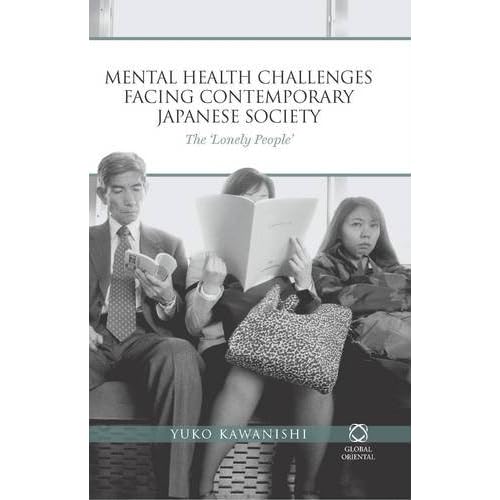
Last week I had the opportunity to hear a talk given by the Japanese sociologist Dr. Yuko Kawanishi. Dr. Kawanishi has written numerous articles and is often quoted by Western media on topics such as declining birth rate, education reform, mental health and depression, family relations, juvenile crime and youth culture. She did her undergraduate work at Doshisha University and got her PhD in Sociology from UCLA. Currently she is the recipient of an Abe Fellowship and a visiting scholar at Hunter College and Columbia University’s Teacher’s College.
Dr. Kawanishi spoke mainly about her new book entitled “Mental Health Challenges Facing Contemporary Japanese Society: The ‘Lonely People.” It addresses the question of mental malaise in its many forms in contemporary Japanese society, focusing on three main areas: work, family and youth. These include Read More
Roland Kelts column in Daily Yomiuri: Our hybrid future is here
Violinist Diana Yukawa
*************
Here’s the latest SOFT POWER/HARD TRUTHS column in the Daily Yomiuri by Roland Kelts (Osaka-shi, 1998-99), author of Japanamerica, this one about hybrid people, hybrid music and hybridization as a trend.
http://www.yomiuri.co.jp/dy/features/arts/20091218TDY11001.htm
Diana Yukawa age 8
******************
JET alum writer Elizabeth White a featured writer on WineTime Tv’s new website
 Elizabeth White (Toyama-ken, 1995-98), the former Media Coordinator for JETAA Southern California, is now a featured writer for WineTimeTv.net. Have a look:
Elizabeth White (Toyama-ken, 1995-98), the former Media Coordinator for JETAA Southern California, is now a featured writer for WineTimeTv.net. Have a look:
http://winetimetv.net/home/contributors
JET Alum Liz Sheffield interviews “Love In Translation” author Wendy Nelson Tokunaga

Author, manuscript consultant and blogger Liz Sheffield (Hokkaio-ken, Sapporo-shi, 1993-95) has a great post on her blog Motherlogue about a new book out titled Midori by Moonlight by Wendy Nelson Tokunaga. Here’s Liz’s explanation of the background:
About a year ago I read Wendy Nelson Tokunaga’s debut novel, Midori by Moonlight. I was thrilled to see that she had a new release out in November — Love In Translation. Both of her books cover topics near and dear to my heart: Japanese culture, the expatriate experience and cross-cultural romance.
Love In Translation intrigued me because the story is told from the perspective of a foreign woman living in Japan, something with which I have personal experience! As I read the book, I had a wonderful sense of being reconnected to my own experiences in Japan — from the visits to a ryokan (Japanese hotel) to eating delicious shu-cream to blunders in communication through a foreign language. I was also reminded of what I learned about myself thanks to the joy and hardship of navigating a culture so different from my own.
In my interview with her at Motherlogue, Wendy offers insight about her experiences in Japan, about publishing two novels and combining her vocal talents with her husband’s musical talents to create an enka song (“Nozomi No Hoshi“) as the soundtrack for Love In Translation. Details about how to request a copy of “Nozomi No Hoshi” on CD, are included in the interview.
- Read the interview with Wendy Nelson Tokunaga, author of “Love in Translation.”
- Read an interview with fellow JET alum Suzanne Kamata about Suzanne’s book Call Me Okaasan: Adventures in Multicultural Mothering.
- Follow Motherlogue here: http://motherlogue.wordpress.com
JET Alum Writing: Jonathan Golub – Private Fund Investment Advisers Registration Act of 2009

Jonathan Golub, Esq. (Saitama-ken, 1996-97)
**************
For JetWit readers working in law or financial services, you may be interested to know that attorney Jonathan Golub (Saitama-ken, 1996-97) was a major contributor to a recent article on the topic of hedge funds and a proposed law that would require many hedge fund managers to register with the Securities Exchange Commission (SEC).
Jonathan is a senior financial services associate at Tannenbaum Helpern Syracuse & Hirschtritt LLP. He advises investment advisers on a wide variety of matters including private investment fund formation and compliance with securities and commodities regulations.
WIT Life #61: 今年の漢字
WITLife is a periodic series written by professional Translator/Interpreter/Writer Stacy Smith (Kumamoto-ken, 2000-03). Recently she’s been watching Fujisankei’s newscast in Japanese and sharing some of the interesting tidbits and trends together with her own observations.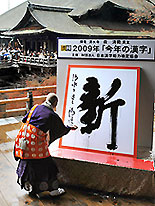
Yesterday at Kyoto’s Kiyomizu Temple the official announcement of 今年の漢字 (kotoshi no kanji), or the Kanji of the Year, took place. This is an annual contest run by the Japanese Kanji Proficiency Society that had a record number of applications from all over the country this year, 161,365. Coming off of last yea r’s
r’s
 selection of 変 (hen) or change, this year’s winner by 14,093 ballots was 新 (shin) or new. Among the reasons why this character was picked were the new political administration and the new strain of the flu.
selection of 変 (hen) or change, this year’s winner by 14,093 ballots was 新 (shin) or new. Among the reasons why this character was picked were the new political administration and the new strain of the flu.
This morning’s news interviewed both young and seasoned prominent political figures regarding what their picks would have been. One was Read More
Roland Kelts article in PaperSky–in Japanese–on hybridization and travel
Here’s a column by Roland Kelts (Osaka-shi, 1998-99), author of Japanamerica, in the Japanese-language travel magazine, PaperSky (http://www.paper-sky.com/blog/). It’s a “mediation on hybridization and travel” and includes photos of the Tokyo, Sydney and NYC skylines.
JET-Popp: Yokohama Children`s Book Conference
**************
Laura Popp (Mie-ken, 2009-Present) is a current JET who writes fantasy and science fiction for children and young adults, and is an occasional playwright/film maker. Her short work includes a short story titled “In theShadow Realm” and a documentary she made in Malawi. To read about her amazing adventures all over Japan, go to her blog at laurajanepopp.blogspot.com. (And check out the Authors/Books section of the JetWit Library for a list of more writers in the JET-o-sphere.)
Hello again! This week I would like to report on the Society of Children’s Book Writers and Illustrators (SCBWI) conference in Yokohama. It actually occurred on November 14th, but, alas, I have been ill with swine flu and other “opportunistic infections” so I was unable to report. But now you get to hear all about it!
For those of you who don`t know, SCBWI is a great group to get involved with if you write for kids. They have lots of events, critique groups, contests, and resources. Here is their website: http://www.scbwi.jp/
A note on transportation. There are many events for writers and translators in Japan, but most are confined to the big cities. For those of you who live in a small town like me, you may be wondering how you will ever get to this wonderful career-building opportunities and still stay within your tight school-teacher budget. Fear not!
There is a wonderful, often overlooked form of transportation in Japan called the night bus. It may seem like a pain, but the bus I took from my home in Nabari to Yokohama was very comfortable. The bus ride was about eight hours, so if I were more accustomed to sleeping on a bus, I probably could have been well rested when we arrived very early in the morning. The earliness gave me plenty of time for sightseeing before the conference, and since my bus home didn`t leave until 11:00pm. Plus it cost less than half than taking the shinkansen, and there`s no need to pay for a hotel!
That said, I was very tired when I arrived back in Nabari at 7:00am. Fortunately it was Sunday, but I would not recommend taking the night bus if you have to go to work the next day. Also, be warned, not all night buses are created equal. Check to see if the bus you want to ride has reclining seats or not, and if there is a bathroom on board or if they stop ever few hours, turn on the lights, and have people jostling past you trying to get in and out constantly. If you are interested in taking a night bus somewhere, I would recommend contacting the main bus station in your town. Most of them don’t speak English, but a Japanese friend helped me get the information and make reservations over the phone. You may be surprised how many places offer night buses to common destinations such as Tokyo, Yokohama, Osaka, etc.
(FYI, Yokohama is famous for its Read More
WITLife is a periodic series written by professional Translator/Interpreter/Writer Stacy Smith (Kumamoto-ken, 2000-03). Recently she’s been watching Fujisankei’s newscast in Japanese and sharing some of the interesting tidbits and trends together with her own observations.
政権交代 (seiken koutai) or “change of government,” was announced to be the winner of Japan’s 2009 Buzzword Award on December 1 (Incidentally, last year the title was won by 「アラフォー」 or “around 40 years old”). This phrase of course refers to the rise to power by Prime Minister Yukio Hatoyama and the Democratic Party of Japan (DPJ), overturning over 50 years of Liberal Democratic Party rule. Other contenders for the buzzword title were 新型インフルエンザ (shingata influenza) or “new flu” and 草食男子 (soushoku danshi) or “herbivorous men.”
Since the change in administration, Hatoyama has been dealing with 3Ks. However, this is not referring to the typical usage regarding undesirable 3K jobs that are kitsui (difficult), kitanai (dirty) and kiken (dangerous). Hatoyama’s very own 3 K’s are kenkin (contribution), keizai (economics), and kichi (military base).
The first K is in regard to a donation scandal plaguing the new Prime Minister. Prosecutors have traced Read More
Sake World e-Newsletter by John Gauntner (November 2009 #2)
 The November 2009 (#2) issue of the Sake World E-mail Newsletter by JET alum and leading sake expert John Gauntner (aka “The Sake Guy”) is now available online. In this issue:
The November 2009 (#2) issue of the Sake World E-mail Newsletter by JET alum and leading sake expert John Gauntner (aka “The Sake Guy”) is now available online. In this issue:
Tasting with Mr. T
Did You Know? Sake Brand Name Characters
New Section: Sake Basics – Junmai-shu
Guided Sakagura Tours
Sake Professional Courses in Japan: Last Call!
Holiday Gift Idea: Announcing The Sake Dictionary!!!
Odds-n-Ends
Additional links:
Sake World Website
More About Us
Archive
Roland Kelts article in “Psychology Today”
Roland Kelts (Osaka-shi, 1998-99), author of Japanamerica, wrote this story about Japan’s unique generation gap for Psychology Today. According to Roland, “things keep changing, but the fundamentals remain the same. Japanese youth are enacting a kind of Bartelby Rebeillion–checking out, passively, to check in.”
Here’s the link to the post: http://japanamerica.blogspot.com/2009/12/psychology-today.html
Hiroshima-ken JET Gail Meadows is Editor of Hiroshima JET webzine the Wide Island View and a regular JetWit contributor who writes the Japan America Society Roundup.
This Thanksgiving I’d like to share with you a story about an experience that one Hiroshima JET was very grateful to have during his time in Japan. This story made headlines in Japanese newspapers in Hiroshima and Niigata prefectures in the summer of 2008, and now we’ve published it in the Wide Island View. My eyes well up every time I read it! I believe that this is one extraordinary example of a JET reaching out and connecting with the Japanese community. So without further ado, let’s begin…
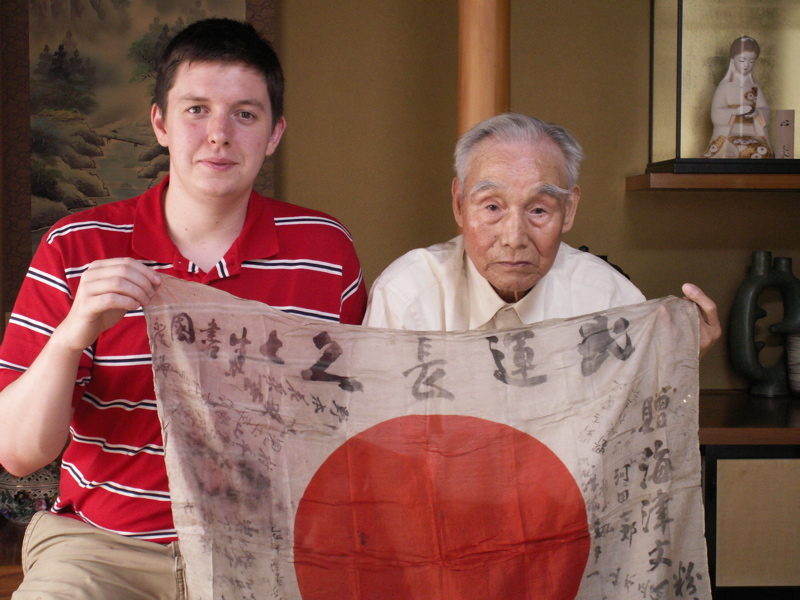 By Aaron Sponseller
By Aaron Sponseller
As I exited Nagaoka Station, I had no idea what would happen over the course of the next several hours. After taking an all-night bus trip from Hiroshima to Tokyo and then hopping on a train for another couple hours to reach this city in Niigata Prefecture, my wife, Tomoko, and I were tired yet enthusiastic to see how this day I had long-awaited would turn out.
We had come to Nagaoka to finish something that was long overdue. My grandfather served in the United States Army for the entire duration of World War II. In the spring of 1945, in the Philippines, he came into possession of a Japanese war flag.
When enemy soldiers were captured, they were stripped of all their gear and military issued clothing. It was not unusual for their captors to take these objects and keep them as souvenirs. Allied soldiers would take Nazi paraphernalia back to their home countries in the European Theatre; they did the same thing with Japanese paraphernalia in the Pacific. Japanese swords, katana, were prized as souvenirs. However, getting a sword back to the U.S. may have proven difficult, so many soldiers looked for smaller or more easily smuggled items. Less conspicuous items. One of the most common items to smuggle home was a Japanese flag.
Before heading to war, most Japanese soldiers took part in a ceremony of some kind that marked their departure. These ceremonies were typically held at Shinto shrines around Japan, with each ceremony marking the departure of several soldiers. During the ceremony, most soldiers were presented with a medium-sized Japanese flag (just the traditional white flag with a red “sun” in the middle). The flags were usually written on, however. The top of the flag read 「武運長久」(pronounced bu-un cho-kyu). This translates to something along the lines of “continued luck in battle.” The flag would also have the name of the soldier on it in large characters, as well as the name of the person at the ceremony who presented that flag to the soldier. The presenter was typically someone important to the soldier such as a boss or a good friend. Around the red sun were the hand-written names of the soldier’s friends or family or otherwise important people. The soldiers carried these flags with them throughout the war as reminders of who they were fighting for.
So, in the spring of 1945, in the Philippines, my grandfather found himself in possession of one such flag. Another soldier had quite a few flags and just gave one to my grandfather. Before I moved to Japan, my grandfather told me “I’ve wanted, for some time, to try to return the flag to the family to which it belongs. But I have no idea how you go about doing anything like that.”
Click here for the rest of the article…
Roland Kelts Daily Yomiuri column: Soft power evolution from Perry’s day to Obama’s
*************
http://www.yomiuri.co.jp/dy/features/arts/20091120TDY13001.htm
FYI, images below are 1) Commodore Perry’s bow, 2) Obama’s bow and 3) Political commentary from Perry’s day.
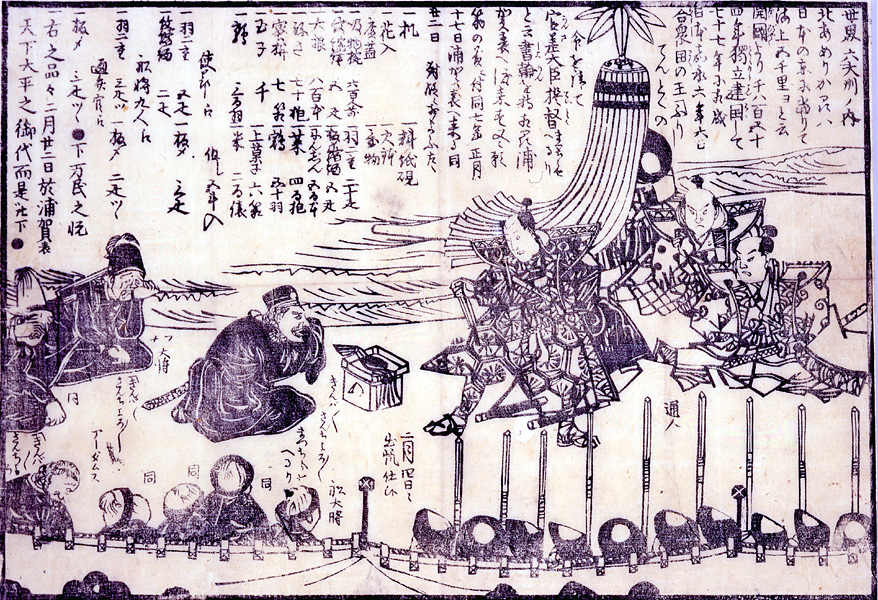
*****
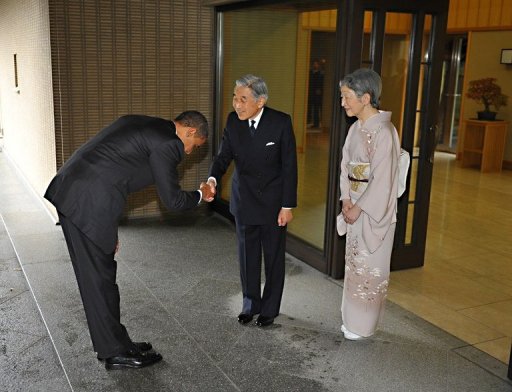 ******
******
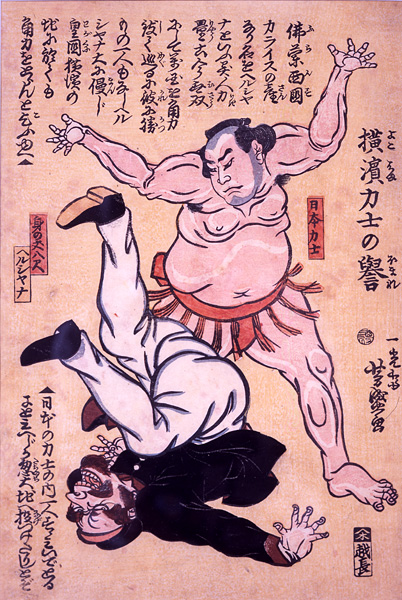
WIT Life #57: Teleworking in Japan
WITLife is a periodic series written by professional Translator/Interpreter/Writer Stacy Smith (Kumamoto-ken, 2000-03). Recently she’s been watching Fujisankei’s newscast in Japanese and sharing some of the interesting tidbits and trends together with her own observations.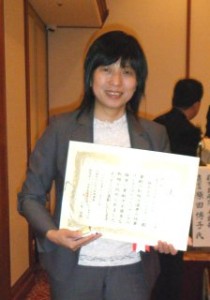
My only time traveling one-on-one as an interpreter for the Department of State’s International Visitor Leadership Program was a year ago with a female entrepreneur from Hokkaido named Yuri Tazawa. No one epitomizes the “Yes We Can” spirit more than Yuri, so it was appropriate that we were able to celebrate Obama’s victory together while in DC. She began a company in a town called Kitami 11 years ago after being raised in Nara, going to university in Tokyo, and starting a family. You might wonder what kind of business one could have being located so far away from a metropolis, but Yuri heads a company called Y’s Staff (taking the Y from her name as well as being a homonym with “wise”).
Y’s has offices in both Hokkaido and Nara, but its actual structure is virtual. Through her company, Yuri is a promoter of teleworking. This concept is often confused with telemarketing, but is essentially the idea of doing work in a place other than a fixed office. This could be your home, the local Starbucks or any other location. Yuri also advocates Read More
![]() JET alum and technical writer David Kowalsky has a nice book review on the book Twitterville: How Businesses Can Thrive in the New Global Neighborhoods in the latest edition of Sound Views, the newsletter for the Puget Sound Chapter of the Society for Technical Writers.
JET alum and technical writer David Kowalsky has a nice book review on the book Twitterville: How Businesses Can Thrive in the New Global Neighborhoods in the latest edition of Sound Views, the newsletter for the Puget Sound Chapter of the Society for Technical Writers.
Here’s the link: http://bit.ly/3hix5A.
Have a look and feel free to share your thoughts on Twitter as well. Also, you can follow JetWit via Twitter at http://twitter.com/jetwit.

